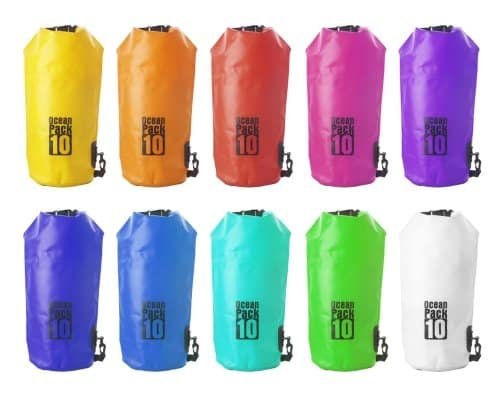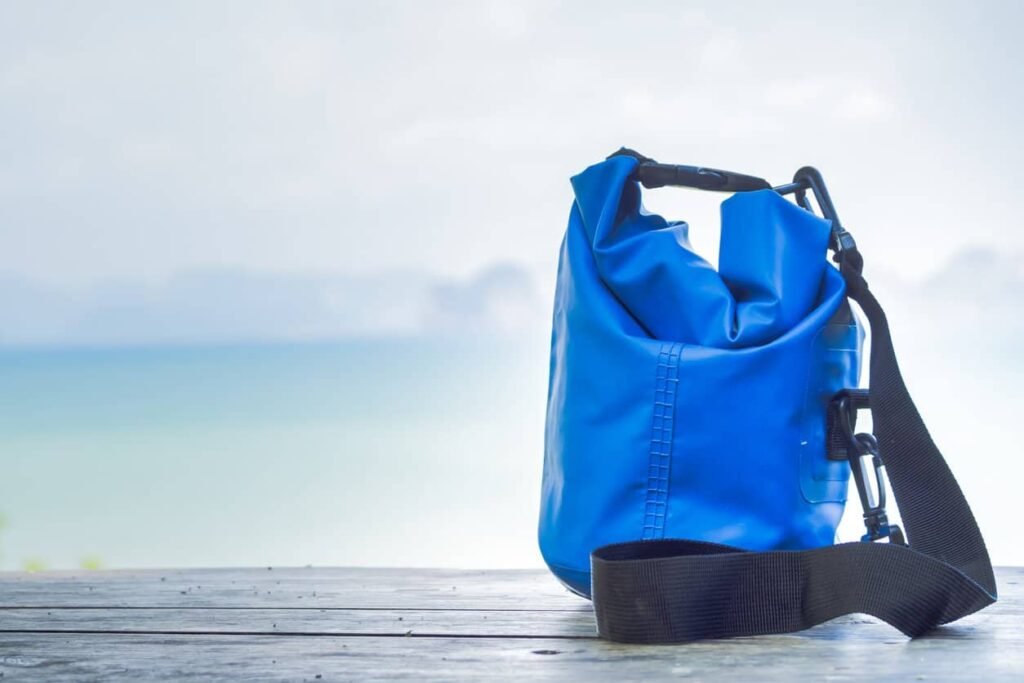
Exploring the outdoors often leads us to confront various elements, especially water. For adventurers and enthusiasts, understanding the difference between a dry bag and a waterproof bag is crucial for protecting gear. This guide will clear up any confusion, ensuring your next adventure is both safe and enjoyable.
At its core, a dry bag is designed for complete submersion, providing a watertight seal, ideal for water sports like kayaking. On the other hand, a waterproof bag is built to resist water but isn’t suitable for prolonged submersion, making it great for light water exposure such as rain.
The World of Dry Bags
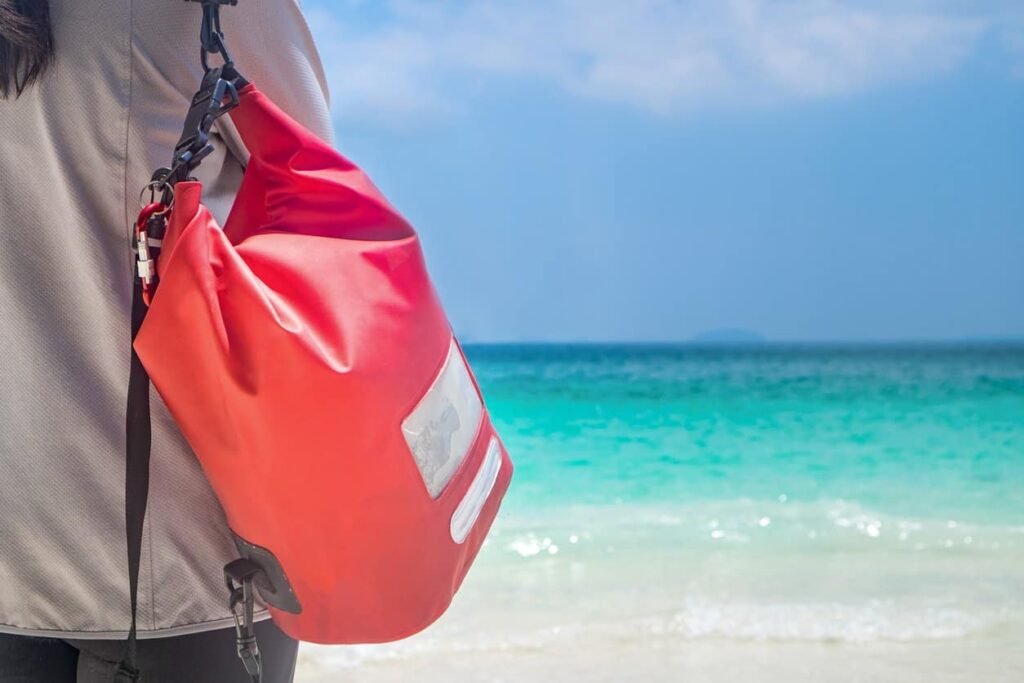
Comprehensive Uses of Dry Bags
- Kayaking and Boating: Ideal for securing items dry during unexpected capsizes or persistent splashes.
- Camping in Moist Conditions: Offers reliable protection for gear against rain or ground moisture.
- Water Sports and Adventure: Invaluable for activities like rafting, snorkeling, or scuba diving, where keeping equipment dry is crucial.
Detailed Features
- Robust Material: Primarily made from heavy-duty materials like PVC or TPU, ensuring resilience.
- Secure Closure: Roll-top mechanism with a clasp, creating a watertight seal.
- Built for Endurance: Designed to withstand harsh conditions, resisting tears and punctures.
Categories and Selection of Dry Bags
- Specialized Dry Bag for Kayaking: Features like attachment points and reinforced construction.
- Ultralight Dry Sacks: Tailored for backpackers, focusing on minimal weight without sacrificing protection.
- Heavy-Duty Variants: Suited for extreme environments, offering the highest level of protection against the elements.
Delving into Waterproof Bags

Waterproof bags are crafted to offer defense against water infiltration but are not designed for situations involving complete submersion. Made typically from water-resistant materials, these bags are adept at handling conditions like rain, surface splashes, or brief dips in water, but prolonged submersion would compromise their effectiveness.
Broad Range of Uses
- Urban and Commuting: Perfect for protecting electronics and documents from urban rain.
- Hiking and Outdoor Trails: Keeps essentials dry during unexpected downpours.
- Beach and Coastal Activities: Effective against sand, sea spray, and occasional water contact.
Notable Features
- Water-Resistant Material: Usually constructed from fabrics like nylon, treated with a waterproof coating.
- Variety of Closures: Features such as zipper closures or roll-tops with water-resistant properties.
- Consideration for Airflow: Some models offer breathable materials, reducing the risk of internal condensation.
Emergency and Safety Uses
- Emergency Flotation Device: In a pinch, air-filled dry bags can aid in flotation.
- Waterproof First Aid Kit: Keeping medical supplies dry in wet conditions.
- Signal Device: Brightly colored dry bags can be used for visibility in rescue situations.
The Advantages of Dry Bags in Extreme Conditions
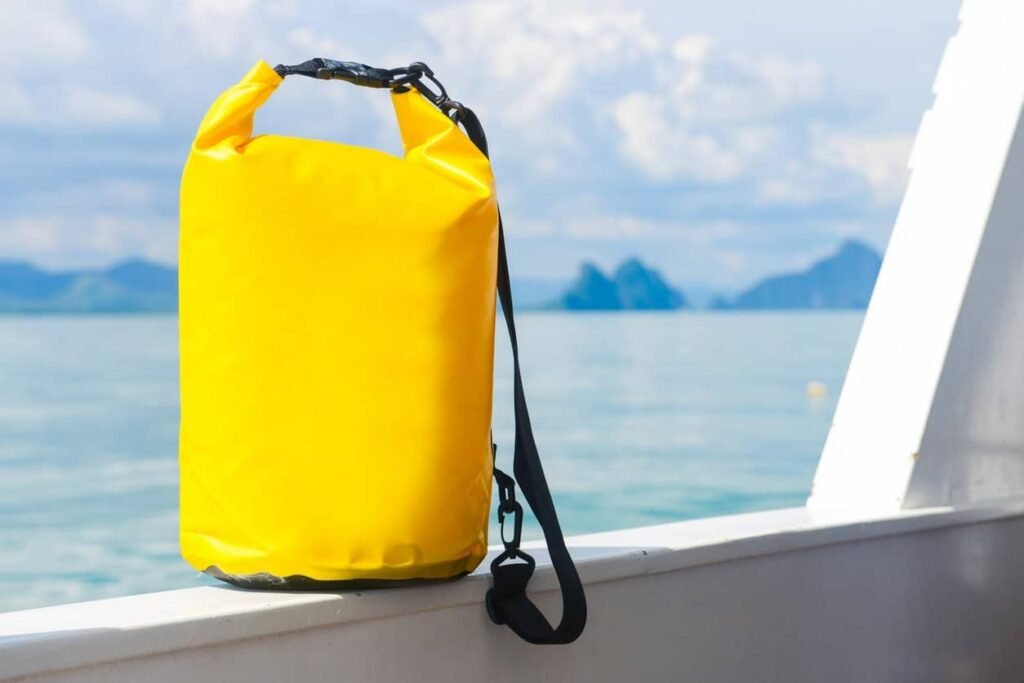
Dry bags are not just storage solutions; they are critical gear for extreme environments. Their ability to withstand full submersion and protect contents from the harshest of elements makes them invaluable in challenging outdoor settings.
Situations Where Dry Bags Excel
-
- Expedition Kayaking: Essential for long trips where gear must stay dry at all costs.
- Flood Rescue Operations: Used by rescue teams for carrying medical and communication equipment.
- Desert Trekking: Protects against sand and dust in arid environments.
Advanced Features
- Extra Reinforcements: Some models feature welded seams and reinforced bottoms for added durability.
- Specialized Designs: Certain bags come with compartments and padding to protect sensitive equipment like cameras.
Innovation in Dry Bag Technology
Recent advancements in dry bag technology have introduced features like transparent windows for easy content identification, lightweight yet durable fabrics, and ergonomic designs that enhance comfort during transportation.
The World of Waterproof Bags: Beyond the Basics
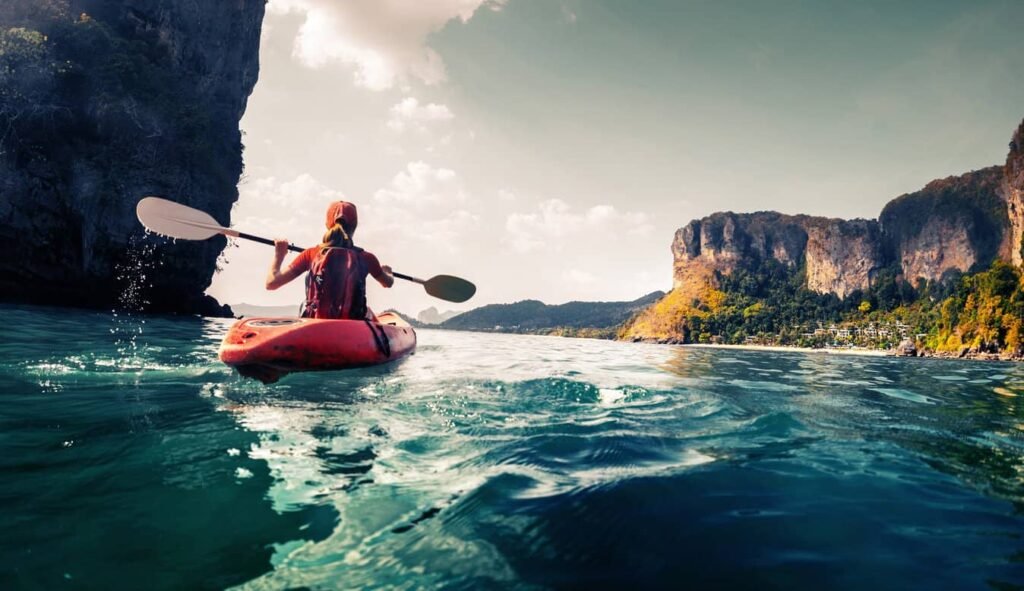
Everyday Scenarios Where Waterproof Bags Shine
- Commuting in Wet Weather: Keeps gadgets and documents dry during rainy commutes.
- Day Hiking: Protects food and clothing from rain showers.
- Waterfront Activities: Ideal for keeping belongings dry at the beach or lake.
Enhanced Features
- Smart Compartments: Organized storage options for easy access and protection.
- Fashionable Designs: Waterproof bags are often designed with style in mind, suitable for urban use.
Evolution of Waterproof Material Technology
Discuss the evolution of waterproof materials, from basic coatings to advanced, breathable, and eco-friendly options. Highlight how these developments have improved the functionality and range of use for waterproof bags.
Sustainable Practices
- Recycled Materials: Utilization of recycled plastics in fabric production.
- Eco-Friendly Coatings: Development of non-toxic waterproof coatings.
- Durability and Longevity: Emphasis on creating long-lasting products to reduce waste.
Making the Right Choice
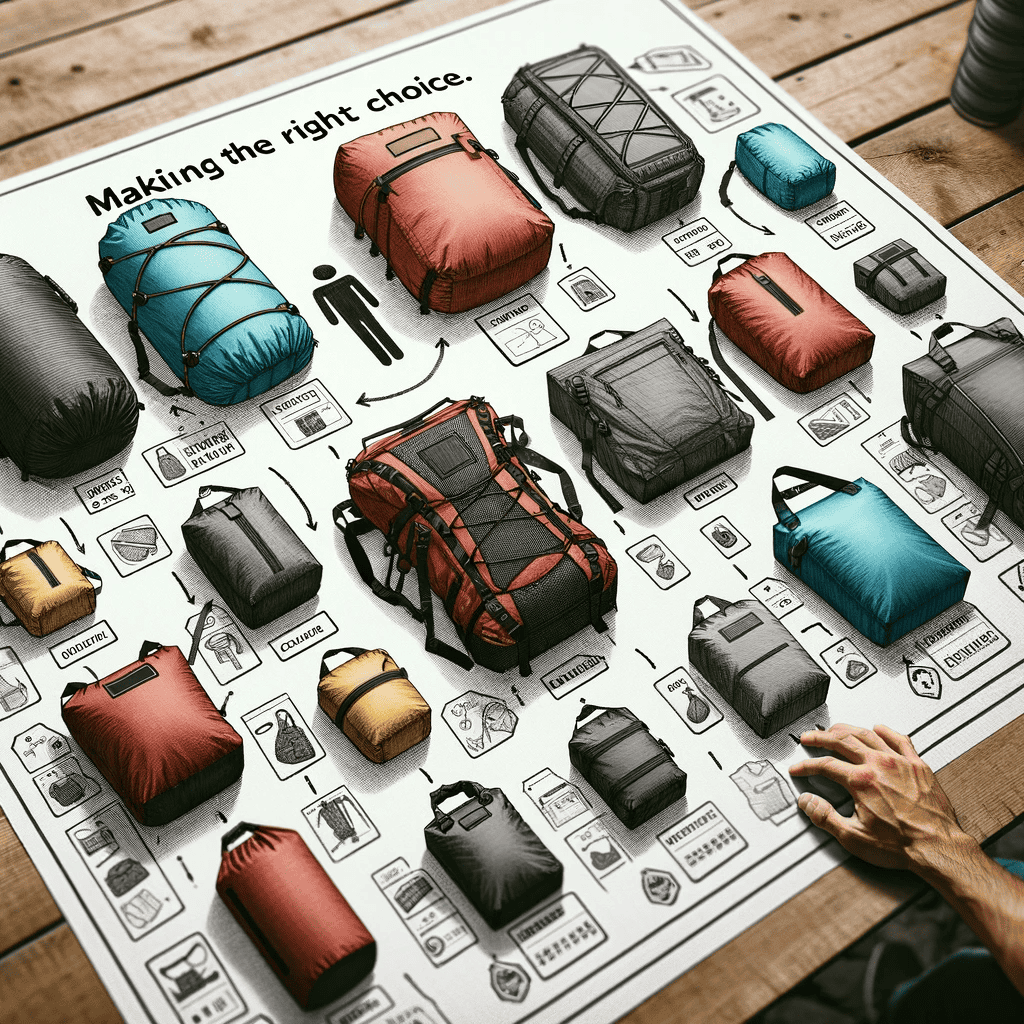
Intended Use
- Dry Bag: If you primarily need protection against water splashes, rain, or brief submersion, a dry bag is a suitable choice. They are great for activities like kayaking, canoeing, or hiking in wet conditions.
- Waterproof Bag: Waterproof bags are designed for situations where full waterproofing is crucial, such as scuba diving, snorkeling, or prolonged exposure to heavy rain.
Capacity
- Dry Bag: Dry bags come in various sizes, from small 5-liter bags to large 30-liter ones. Choose a size that accommodates your gear without excess space, as air inside the bag can affect buoyancy.
- Waterproof Bag: These bags also vary in capacity, but they often have a more straightforward, backpack-like design. Select a size that fits your gear comfortably.
Durability
- Dry Bag: Dry bags are known for their ruggedness and resistance to abrasions. Look for materials like PVC or heavy-duty nylon, as they offer excellent durability.
- Waterproof Bag: Waterproof bags are designed to withstand the harsh conditions of water sports. They are typically made from durable materials and feature reinforced seams and closures.
Closure Mechanism
- Dry Bag: Common dry bag closures include roll-top and zip-lock designs. Roll-top closures are more secure against water penetration, while zip-lock closures provide quick access.
- Waterproof Bag: Waterproof bags often feature airtight zipper closures or roll-top designs with additional sealing mechanisms. These closures ensure maximum waterproofing.
Budget
- Dry Bag: Dry bags are generally more budget-friendly and offer good value for their waterproofing capabilities.
- Waterproof Bag: Waterproof bags may be more expensive due to their specialized features and materials. Consider your budget when making a choice.
Maintenance and Care
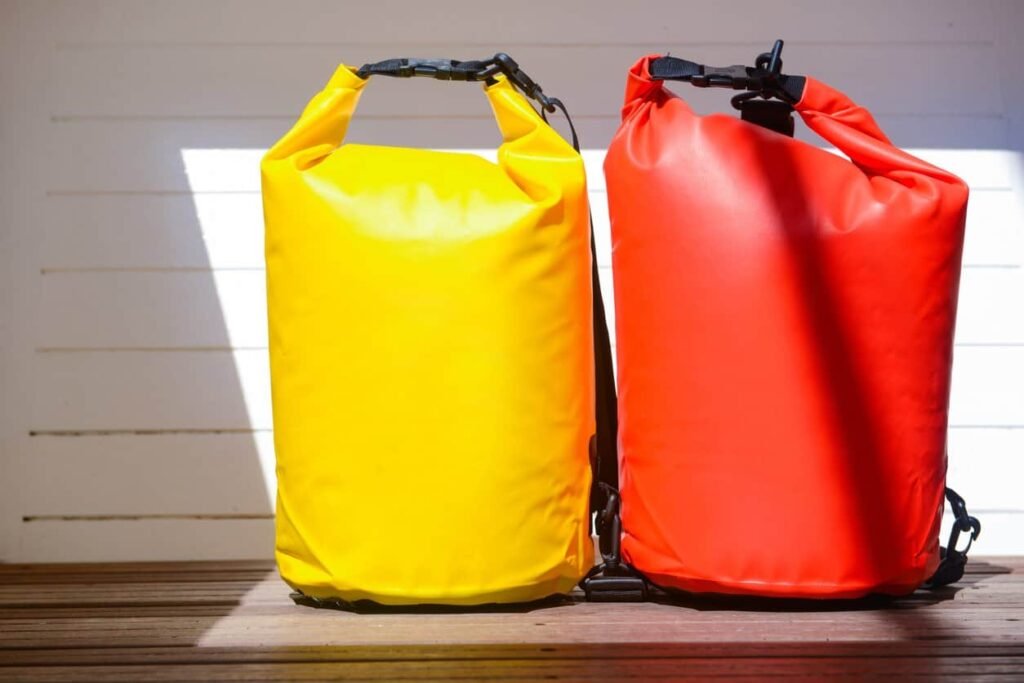
Rinse and Dry After Use
After each use, rinse your bag with fresh water to remove any sand, salt, or contaminants that could damage the material.
Inspect for Damage
Regularly inspect your bag for any signs of wear, tears, or punctures. Check seams, closures, and straps for damage. Address any issues promptly to prevent further damage.
Clean Thoroughly
Use a mild detergent or specialized bag cleaner to clean the interior and exterior of your bag as needed. Avoid harsh chemicals, as they can degrade the bag’s waterproof coatings. Rinse thoroughly and dry completely after cleaning.
Avoid Overloading
Avoid overloading your bag beyond its recommended capacity. Excessive strain on the bag’s seams and closures can lead to leaks or damage over time.
Store Properly
When not in use, store your dry bag or waterproof bag in a cool, dry place away from direct sunlight. Ensure it is completely dry before storing to prevent mold or mildew growth.
Perform Regular Waterproof Tests
Periodically perform waterproof tests to ensure the bag’s integrity. Fill the bag with tissue paper, seal it, and submerge it in a bathtub for a few minutes. If the tissue remains dry, your bag is still waterproof. If not, it may be time for repairs or replacement.
Essential Accessories
- Waterproof Pouches: For smaller items like phones or wallets.
- Modular Packing Systems: Helps in organizing gear within larger bags.
- Attachable Pockets: Increases storage options without compromising waterproofing.
In-Depth Maintenance Tips
- Cleaning Techniques: For dry bags, use a mild soap and a soft brush to gently clean the surface. Waterproof bags can often be wiped down with a damp cloth. Avoid machine washing, as it can degrade the materials and waterproof coatings.
- Drying Methods: Air dry both dry and waterproof bags away from direct heat sources. Open the bag fully and hang it upside down to ensure complete drying, especially in the seams and folds.
- Storage Solutions: Store both types of bags in a cool, dry place. Avoid folding or crumpling the bags, as this can cause creases that weaken the material over time. Instead, loosely roll or lay them flat.
Repair and Damage Prevention
- Seam Maintenance: Regularly check the seams and closures for signs of wear. For minor seam damage, use a waterproof sealant specific to the bag’s material.
- Avoiding Sharp Objects: Be cautious about what you pack. Sharp objects can puncture or tear the material, compromising the bag’s waterproof integrity.
- UV Protection: Prolonged exposure to sunlight can degrade the fabric of the bags. If used in sunny conditions, consider bags with UV-resistant materials.
FAQ
Q1:What defines a dry bag?
A:A dry bag is designed to be completely airtight and watertight, primarily used in activities with significant water exposure.
Q2:What’s unique about a waterproof bag?
A:Waterproof bags are built for water resistance, apt for moderate exposure to elements like light rain and splashes.
Q3:When is a dry bag preferable to a waterproof bag?
A:Opt for a dry bag in scenarios with potential for full submersion or heavy water contact.
Q4:How should I care for my dry or waterproof bag?
A:Regular cleaning with mild soap, dry storage, and frequent inspections will maintain their integrity.
Q5:Can dry bags serve as flotation aids?
A:While not designed for this purpose, properly sealed dry bags can offer some level of buoyancy.
Conclusion
Grasping the distinction between dry bags and waterproof bags is vital for selecting the appropriate gear for your outdoor endeavors. Whether facing the rapids or just a rainy day, choosing the right bag can dramatically affect the outcome of your adventure, keeping your belongings secure and dry.

